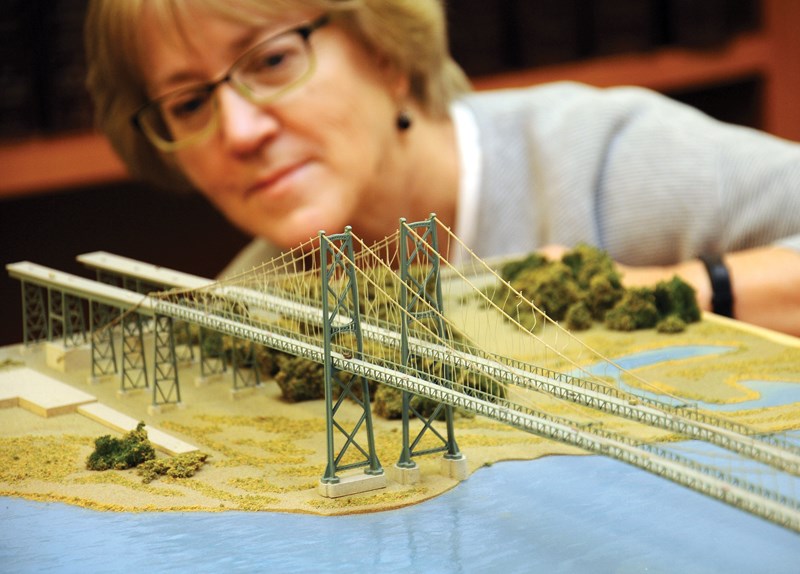A recent acquisition by the North Vancouver Museum and Archives conveys something of an alternate timeline for the North Shore, one that for many might have meant a less infuriating commute.
Nestled safely in the organization’s archives room in Lynn Valley, currently not on display, lies a proposed twinned version of the Lions Gate Bridge – except this one is six feet in length, not 6,000.
“I’m fascinated by what might have been,” says museum and archives director Nancy Kirkpatrick about the model, dating from 1994, that the museum came into possession of last year.
The museum’s reference historian Daien Ide was tipped off that the Burnaby Hospice Thrift Store on Kingsway was in possession of a Lions Gate Bridge model with a unique twist.
The historic item was being sold with an attached price tag somewhere around $200, Kirkpatrick explains.
When the idea was floated that the museum should look into bringing the model back home, she says the answer of how to proceed was instantly clear.
“Immediately I said, ‘Absolutely,’” she says. “We want to be a museum about our community -- past, present and future. What is one of the perennial, most important topics on the minds of people that live and work here? Transportation.”
Perennial is right, especially considering the twinned bridge model was created as a serious proposal meant to help alleviate some of Vancouver and the North Shore’s traffic woes.
The Lions Gate was first opened in 1938. By the time the 1990s rolled around, however, the bridge required extensive repairs or, as many proposed, a total bridge replacement.
Information collected by the museum in the wake of the model discovery explains that debate at the local and provincial level over the course of many years produced numerous public input sessions, reports, government studies, and engineering proposals.
Should a new bridge be built altogether?
Should a double-decker bridge be constructed, or should a tunnel be built under the Burrard Inlet?
These were the questions that kept planners, architects and municipalities up at night.
The Squamish Nation, who owned the land on the north end of the bridge, proposed an idea to twin the bridge in partnership with Montreal-based architect Moshe Safdie and engineering firm SNC-Lavalin.
The model that’s now in the museum’s possession bears the mark of Safdie Architects, famous for designing and helping construct such treasured Canadian buildings as the National Gallery in Ottawa, Habitat 67 in Montreal, and Vancouver’s own public library.
Upon observing the model, Kirkpatrick says she likes the twinning of the bridge idea because it wouldn’t have necessarily disrupted the look and feel of the original bridge.
“It’s just a twin of it, but it does provide the additional traffic flow which is as we all see now, as development increases the pace in our region, that we need to have more capacity,” she says.
Ultimately, in 1998 after decades of debate the B.C. government abandoned plans to replace or significantly alter the Lions Gate, instead opting to upgrade the existing bridge without expanding it.
“It’s such a quirky story,” says writer and local historian Eve Lazarus, who first blogged about the museum’s acquisition of the model back in August for a series she has dubbed Saving History.
“It’s just really interesting when you look at these aborted plans and think we’re still grappling with these same issues.”
She adds that while she loves the look of the model and the idea of twinning the bridge, she’s hesitant about what might have happened to Stanley Park if significant redevelop or replacement of the bridge had been undertaken, which might have meant expanding the number of
lanes on the causeway or deforesting a large portion of the northbound entrance.
“They would have had to have taken a chunk out of it.”
While it’s still a mystery exactly how the model ended up at the Burnaby thrift store after all these decades -- presumably after an individual donated it to the store after finding it in a back alley, according to Kirkpatrick – the museum is happy to have it.
Last year, the City of North Vancouver approved the construction of a new 16,000-square-foot home for the North Vancouver Museum and Archives.
The new location, which will be located on the 100 block of West Esplanade, is slated to open in 2019 across from Lonsdale Quay and the new Polygon Gallery.
Kirkpatrick hopes the twinned bridge model can find a home in the new museum as a testament to the city’s past and a look at what could have been.
“We’ve got the high-level concepts as we head into this next phase, then we’ll start identifying the artifacts that are going to be used to carry through the big themes and stories,” she says.
“We’ll know at that point whether we have a spot in the permanent exhibit for this model or whether it will be something that we’ll design some other kind of exhibit around.”
The museum has been deaccessioning, or getting rid of some artifacts, in recent years in order to free up space for items of cultural and historic importance, such as the twinned bridge model, that represents the story of the North Shore, Kirkpatrick says.
“The reason we’re doing that is to make room for cool, new things and for things that really relate to the key themes of our community,” she says.
“We’re interested, in general, in this whole issue of what connects North Vancouver to the rest of our region.”
In 2000 and 2001, the main deck of the bridge was replaced in an effort to repair the ailing structure after plans to possibly replace or significantly alter the bridge faltered.
In 2005, the Lions Gate Bridge was declared a National Historic Site of Canada, Identified as one of the country’s “technical and engineering landmarks,” by the nation’s Historic Sites and Monuments Board.
Talk of the North Shore’s perennial traffic problems persists to this day.



